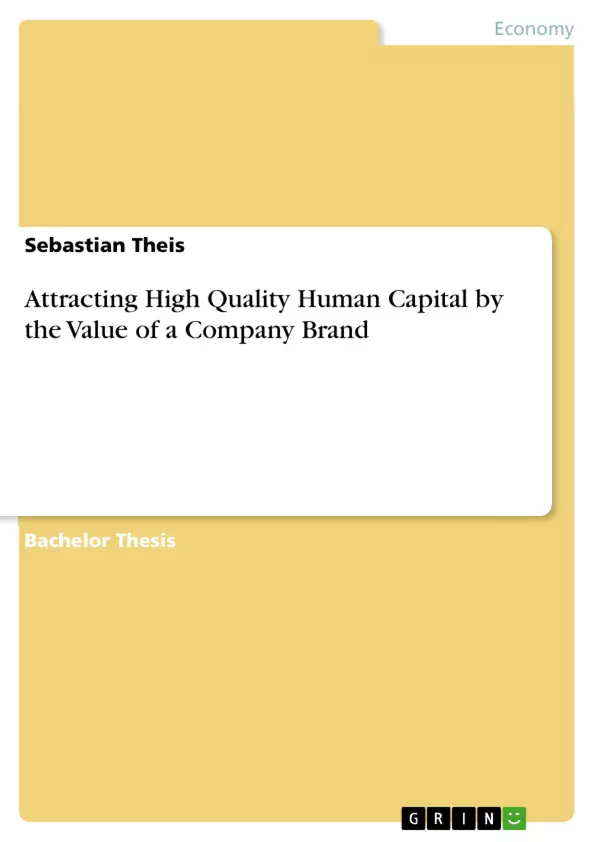It is indisputable that brands influence operating results as well as the reputation of a firm. Some statements even consider a brand as one of the most valuable assets of a company.
The relation between the brand and the consumer can be considered as a pact. The customer is loyal and trustful while the brand guarantees a consistent quality and pricing. What is questionable is whether a brand has the same effect on current and potential employees. Hence the question is: Does a brand also influence the employer attractiveness?
Improving or even creating a brand’s value requires a variety of both expensive and risky actions. This is one of the reasons many companies may under invest in that area. From the business point of view, the threat of spending money on measures which do not have a relevant effect on the business bears no relation to the few benefits to be expected. Thus, especially for SMEs, it is essential to know if investments to increase the brand value can be beneficial for a company’s recruitment.
Practice shows that the market activity of a company does influence the image also as an employer. Good examples are BMW and Porsche whose employer brand also benefits from the success of their businesses.
The knowledge about a correlation between the brand value and the attractiveness as an employer can be of big advantage for companies that do not maintain a valuable brand. They would get a chance to change their mindset concerning the investments in creating brand value in order to attract high quality human capital and benefit from other advantages a known brand brings in.
Inhaltsverzeichnis (Table of Contents)
- 1. Introduction
- 1.1 Problem Description
- 1.2 Objectives
- 1.3 Methodology
- 1.4 Research Relevance
- 1.5 Structure of the Work
- 2. The Capital Facet of Human Resources
- 2.1 Properties of Human Capital
- 2.2 Measuring Human Capital
- 2.2.1 Classical Methods
- 2.2.1.1 Market-Based Valuation
- 2.2.1.2 Result-based Valuation
- 2.2.1.3 Company Equity Valuation
- 2.2.2 Indicator-based Methods
- 2.2.2.1 Scandia Navigator
- 2.2.2.2 Human Capital Value Drivers
- 2.2.2.3 Balanced Scorecard
- 3. Parameters & Variables of Motivational Drivers
- 3.1 Intrinsic Motivation
- 3.2 Extrinsic Motivation
- 3.3 Content Theory
- 3.3.1 Maslow - Hierarchy of Human Needs
- 3.3.2 Alderfer - ERG Theory
- 3.3.3 Herzberg - Two-Factor Theory
- 3.3.4 McClelland - Achievement Motivation
- 3.4 Process Theory
- 3.4.1 Adams - Equity Theory
- 3.4.2 Vroom-VIE Theory
- 4. Assessing Brand Value
- 4.1 Properties of Brand Value
- 4.2 Measuring Brand Value
- 4.2.1 Financial Models
- 4.2.1.1 Economic-use approaches
- 4.2.1.2 Cost-based approaches
- 4.2.1.3 Marked-based approach
- 4.2.2 Behavior-related Models
- 4.2.3 Indicator Models
- 5. Derivation of Framework for Practical Application
- 5.1 Criteria of Motivation and Value of Brands
- 5.1.1 Selecting Motivational Factors
- 5.1.2 Selecting Brand Value Approach
- 5.2 Correlation of Brand Value and Motivation Theories
- 6. Assessing Theoretical approach in Practice
- 6.1 Investigation of Correlation of Brand Value and Employer Attractiveness
- 6.2 Examination of the Brand as a Motivational Factor at Work
- 6.3 Interpretation of the Results
- 7. Conclusion and Future Research Direction
- 7.1 Target Achievement
- 7.2 Prospects & Outlook
Zielsetzung und Themenschwerpunkte (Objectives and Key Themes)
This Bachelor Thesis aims to investigate the correlation between brand value and the ability of a company to attract high-quality human capital. By exploring various models and theories related to both human capital measurement and brand value assessment, the study seeks to understand the potential of a strong company brand to serve as a motivational factor for employees.
- The importance of human capital as a crucial asset for organizations.
- The significance of brand value in attracting and retaining skilled employees.
- The relationship between various motivational theories and brand value perceptions.
- The practical implications of integrating brand value into human capital management strategies.
- The potential of using brand value as a key factor in attracting and retaining high-quality talent.
Zusammenfassung der Kapitel (Chapter Summaries)
The first chapter introduces the problem statement, outlining the objectives, methodology, research relevance, and the overall structure of the work. Chapter two delves into the concept of human capital, discussing its properties and exploring various methods for measuring its value. Chapter three examines different parameters and variables that influence motivational drivers, focusing on both intrinsic and extrinsic motivation. The chapter also reviews prominent content and process theories of motivation, such as Maslow's Hierarchy of Needs, Alderfer's ERG theory, Herzberg's Two-Factor theory, and Vroom's VIE theory.
Chapter four shifts the focus to brand value, exploring its properties, different measurement approaches, and specific models for assessing its financial and behavioral aspects. Chapter five combines the insights from the preceding chapters to derive a framework for practical application, highlighting the correlation between brand value and employee motivation. Finally, Chapter six delves into the practical implications of the proposed framework, examining the correlation between brand value and employer attractiveness through empirical analysis.
Schlüsselwörter (Keywords)
This Bachelor Thesis explores the relationship between brand value and the attraction of high-quality human capital. Key themes include human capital management, motivational theories, brand value assessment, and employee engagement. Specific areas of focus include the use of brand value as a strategic tool for talent acquisition and retention, the impact of brand perception on employee motivation, and the practical application of theoretical frameworks in organizational settings.
- Arbeit zitieren
- Sebastian Theis (Autor:in), 2010, Attracting High Quality Human Capital by the Value of a Company Brand, München, GRIN Verlag, https://www.hausarbeiten.de/document/154020


